Description of ordinary pumpkin (hard-bore, pepo): composition and properties, characteristics, nuances of cultivation and use
The plant in question has been known for more than one millennium. It grows almost everywhere. For its medicinal properties, it is called the orange or yellow doctor. The spectrum of his action is so wide that you can safely write a book about him, and more than one. So, what are we talking about?
The content of the article
What is "Pepo" and what it is eaten with
In Latin, this plant is called Cucúrbita pépo, but we are more accustomed to call it differently - common pumpkin, or hard pumpkin... It is also called pepo pumpkin. This annual herb of the pumpkin family belongs to melons and gourds.

Such a different pepo
Common pumpkin has several varieties: directly the pumpkin itself, zucchini and squash. They also belong to the hard-headed. Only they are used for food not after complete ripening and hardening of the crust, but young, when the skin is still tender and soft, and the fruits are small.
Directly herself pumpkin is divided into three more subgroups:
- table varieties (a person uses them for food);
- forage varieties (usually have a large fruit size, suitable for animal feed);
- decorative varieties (medium-sized fruits, interesting color and shape, such species are planted near walls and hedges, used for crafts and ikebana).
The solid varieties Golosemyanka and Danae are especially popular. (both varieties do not have a hard shell and peel on the seeds), Freckle, Dachnaya, Orange Kustovaya, Acorn. All these varieties are table varieties. They have excellent taste characteristics and a lot of useful properties.
By the way! There is no clear gradation between food and feed varieties. The only difference is in size and taste.
From a botanical point of view (description and photo of the plant)
The root system of the hard-bore pumpkin is pivotal with branches... The length of the stem is from 5 to 8 meters, it does not grow up, but spreads, rooted weakly at the nodes. The stems themselves have five faces, are covered with grooves, and are covered with small spines, like the leaves of a pumpkin. In such representatives of hard-bore as squash and squash, the stem is much shorter, the leaves are arranged in a bush.
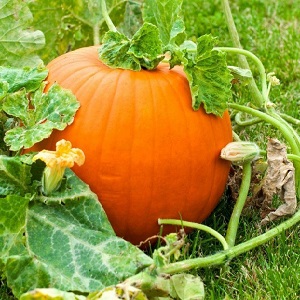 The leaves have long petioles, spiral antennae are located in the axils... The leaves are divided into five sections. Pumpkin flowers are single, 5 to 7 cm long, divided into two sexes, orange or yellow. The plant blooms in June-July. Flowers are most often pollinated by bees.
The leaves have long petioles, spiral antennae are located in the axils... The leaves are divided into five sections. Pumpkin flowers are single, 5 to 7 cm long, divided into two sexes, orange or yellow. The plant blooms in June-July. Flowers are most often pollinated by bees.
The fruits of the common pumpkin are in the form of an oval or a ball., the shell is hard, its color varies depending on the type of plant. The size of the pumpkin also depends on the variety. Fodder varieties sometimes grow to impressive sizes. The fruit usually reaches maturity in the period from August to September, contains a large number of seeds - seeds. The seeds of the plant are teardrop-shaped, but flat, not convex. Covered with a hard shell.
It will be interesting:
How to choose and prepare pumpkin seeds for planting
The best varieties of bush pumpkin and features of their cultivation
The benefits of hard bark and its composition
Common pumpkin, like its other "sisters", is a storehouse of vitamins and mineralsbeneficial to the body. This vegetable is perfect for dietary nutrition and helps in the treatment of many diseases.
Important ingredients
The common pumpkin contains:
- vitamins E, C, H, K, PP, A, beta-carotene (provitamin A), vitamins from group B;
- trace elements significant for the body: fluorine, zinc, vanadium, boron, aluminum, iodine, iron, cobalt, chromium, selenium, manganese, rubidium;
- carbohydrates are represented by starch and dextriome, fructose, sucrose and glucose, disaccharides, monosaccharides;
- important polyunsaturated fatty acids omega-6 and omega-3.
The properties are wonderful - very useful
Berry is a vegetable, because pumpkin can be safely attributed to this category, it has beneficial effect on almost the entire human body:
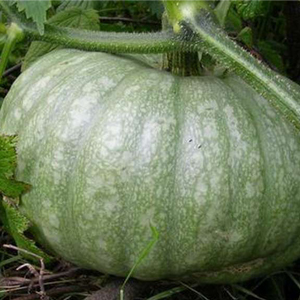 Debugs the functioning of the digestive system. With it, food is absorbed more efficiently and faster.
Debugs the functioning of the digestive system. With it, food is absorbed more efficiently and faster.- Pumpkin is often used in various diets. There are few calories in it, because it is more than half of water.
- Regular consumption of vegetables normalizes blood pressure levels. An additional effect is that headaches are gradually reduced.
- It has long been known that "plump" has an antioxidant effect. This promotes the elimination of toxins and allows you to maintain youth as long as possible.
- Pumpkin masks help to cope with age-related changes. Their effect is akin to a salon one. The main properties are to whiten, deal with inflammation, even out skin tone.
- The nervous system suffers without B vitamins. There are an abundance of them in pumpkin, because its use reduces the degree of stress and the severity of depressive conditions.
- This vegetable will also help solve the problem of iron deficiency. Its positive effect on blood composition was noted.
- Pumpkin also has a beneficial effect on blood vessels, which prevents the development of varicose veins and thrombophlebitis.
- To have falcon vision, it is also beneficial to eat an orange vegetable, as it is effective in preventing eye diseases.
- The immune system is activated by regular intake of pumpkin. The vegetable has an anti-inflammatory effect and helps to remove mucus accumulating in the lungs.
- The firm "plump" is often used in the fight against the phenomenon of thickening of bile. It also helps cleanse and renew cells.
- Our heroine is a good help in preserving male health, for the treatment and prevention of diseases of the genitourinary sphere.
Where grows
Common pumpkin, like most of its relatives, is not particularly picky about climatic conditions, therefore, it is common almost everywhere. In our country, it was grown first in the southern regions, and since the 19th century, the plant has become more widespread, and even reached Siberia. The vegetable grows well in places with warm and moderately warm climates.
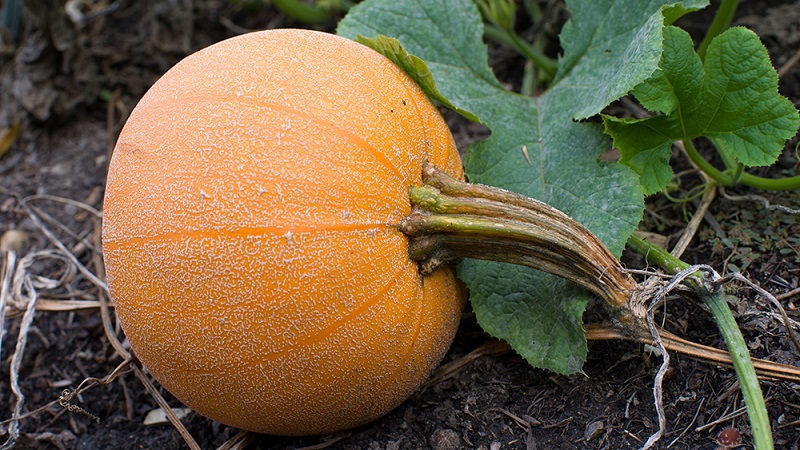
Important for growth
Pumpkin is unpretentious - it can grow on almost any soil... An exception is swampy or clayey places where the soil is heavy. The "fat woman" loves the sun, but it will be quite satisfied with a penumbra place. In very shady places, the fruits grow small.
In most territories of Russia, pumpkin is planted immediately in the ground, but in some places where the climate is cooler, it is advisable to grow the vegetable using seedlings.
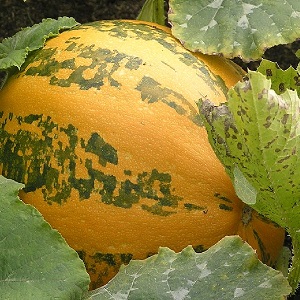 The distance between the holes when planting in the ground is left about a meter, between the rows - from 2 to 2.5 meters... It is better to plant in a checkerboard pattern. It is preferable to make holes up to 30 cm deep, spilling water before planting. Between the bushes of seedlings when planting in the ground, you need to maintain the same distance, after planting, pour 2-3 liters of water for each bush. You can put a handful of humus in the hole.
The distance between the holes when planting in the ground is left about a meter, between the rows - from 2 to 2.5 meters... It is better to plant in a checkerboard pattern. It is preferable to make holes up to 30 cm deep, spilling water before planting. Between the bushes of seedlings when planting in the ground, you need to maintain the same distance, after planting, pour 2-3 liters of water for each bush. You can put a handful of humus in the hole.
The pumpkin root is well developed, so it copes well with the dry period.... But abundant watering serves as an additional plus for her. It is easy to determine whether it is time to water the "fatty": if the leaves have begun to fade, then it is time for watering. Planted pumpkin seedlings should be watered daily until they begin to grow. Then watered as needed.It is recommended to resume daily watering when the fruits are the size of a large apple.
Application of the orange fruit
The range of application of pumpkin is very extensive... Traditionally, it is used to prepare various dishes. In addition, the "fat woman" helps to overcome many diseases or significantly reduce their manifestations. Pumpkin masks have an excellent anti-inflammatory and anti-aging effect.
Kitchen treasure
The pumpkin menu is very varied... Porridge with vegetables in water or milk are popular (most often rice or millet is used). Pies and pancakes are made with the grated "fatty". Pumpkin is baked in the oven alone or with the addition of other fruits, nuts and honey. They even prepare salads and desserts from raw vegetables.
Heals many diseases
For the treatment of diseases, both raw vegetables and medicines based on it are used.... There are recipes with seeds, flowers, leaves. Pumpkin is used to cleanse and renew the liver and the whole body. The yellow "plump" helps with inflammation of the urinary tract and small stones in the gallbladder, perfectly liquefies bile, relieves cirrhosis and fatty hepatosis.
Excellent restorative, cleanser and restorative agentuseful both for the liver and for the whole organism as a whole, - pumpkin honey. You can cook it yourself:
- peel a small pumpkin from seeds;
- fill with honey;
- close a pumpkin lid cut with a handle and cover with a cotton cloth on top;
- put in a cool place for 7-10 days;
- syrup is formed inside - this is a healing agent.
For youth and beauty
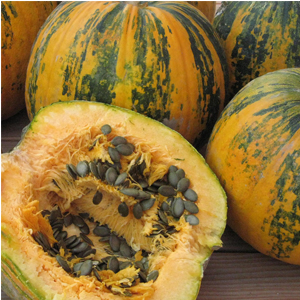 Masks with pumpkin do an excellent job with skin inflammation, smooth it out. If you eat a little raw pumpkin regularly, not only the condition of the skin improves, but also the hair: dandruff disappears, the curls become silky.
Masks with pumpkin do an excellent job with skin inflammation, smooth it out. If you eat a little raw pumpkin regularly, not only the condition of the skin improves, but also the hair: dandruff disappears, the curls become silky.
Masks with vegetables, with regular use, are akin to salon care, because they have an excellent lifting effect... So, it is useful to mix boiled pulp with egg, honey and heavy cream. This tool is applied for 15-20 minutes. 1-2 times a week. After the procedure, you should wash off the remnants of the product with warm water and lubricate the skin with your favorite cream. To prepare the mask you will need:
- boiled pumpkin pulp - 50 g;
- chicken egg - 1 piece;
- honey - 1/2 tsp;
- heavy cream - 2 tbsp. l.
For a slim figure
Pumpkin is not only low in calories, and therefore is used in dietary nutrition... If you eat a vegetable daily, it helps to activate metabolism and normalize the digestion process. Thanks to him, heavy food is absorbed faster and better. For those who eat pumpkin on a regular basis, the portions are significantly reduced, because its natural fiber allows you to fill up faster.
Pumpkin is a natural energetic... It fills the body with vigor, and an increase in physical activity will certainly have a positive effect on weight. Excellent weightloss remedy - fasting days with pumpkin. There are many pumpkin diets. Continuing to use the "fat" after achieving the desired result, it is much easier to maintain the normal weight.
There are restrictions
Pumpkin has few contraindications:
- allergies or individual intolerance;
- Large stones in the gallbladder or kidneys (may move and block the ducts)
- dessert varieties are not recommended for diabetics;
- exacerbation of diseases such as low acidity gastritis, cholecystitis, pancreatitis, gastric and / or duodenal ulcer;
- liver disease in the acute stage.
It is important! With all the usefulness of the product, the presence of chronic or acute diseases is a reason to consult a doctor before introducing the product into your diet or starting treatment procedures with it.
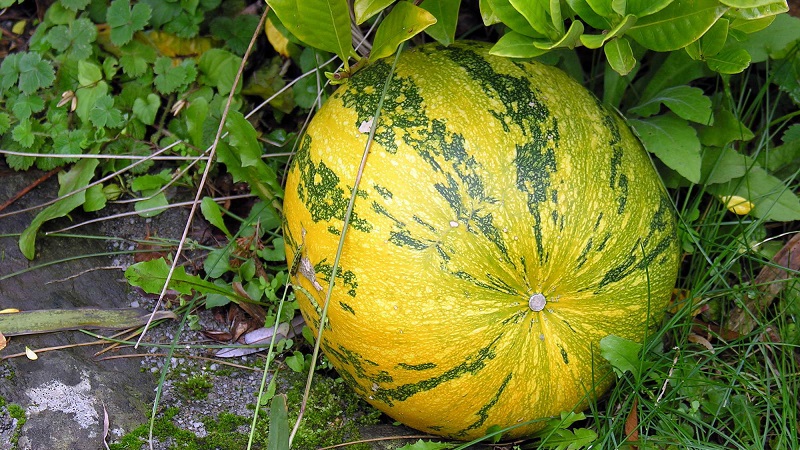
Reviews
Best of all about our "heroine", of course will tell those who have already tried to use or plant a vegetable.
Anna, 28 years old: “I didn't even imagine that a mask could be made of pumpkin, although it is a frequent guest on my table.I noticed for a long time that the best masks are natural. I tried it - I didn’t regret it. The facial skin looks soft and well-groomed. I think I will do it regularly, they say, then the effect is better. It is also necessary to introduce raw pumpkin into the diet, I read a lot about its benefits. I tried this salad: finely chopped or just grated pumpkin, lightly poured with lemon juice, you can add a drop of sugar or honey. Both tasty and healthy! "
Irina, 35 years old: “I bought seeds of hard-bore pumpkin gymnosperms in the store. At first I thought it was a hoax, but the seeds planted for the experiment on the site have sprung up and grown safely. I was very worried before cutting my pumpkin: what will it be? It turned out to be just a godsend! Pumpkin pulp is fragrant and sweetish. And the seeds are simply not conveyed! There were many of them inside, and also without a shell. Very tasty and pleasant to eat - no labor of cleaning and debris from the husk. I will plant more next year ".
Conclusion
Ordinary hard pumpkin, or pepo, is a common plant that is unpretentious to growing conditions. She has many varieties, you can choose for every taste. It is stored mainly well, and the taste of pulp and seeds, especially in gymnosperms, is quite high.
This melon culture is suitable for preparing various dishes. Medicines based on it help to get rid of many diseases, maintain youth, and cleanse the body. The vegetable is recognized as an excellent aid in the fight against obesity. The fat woman is irreplaceable in cosmetology. If eaten raw, hair and skin will look great; cosmetics - masks and lotions - contribute to the same effect. In general, pumpkin from all sides is a useful product, therefore it has more admirers from year to year.